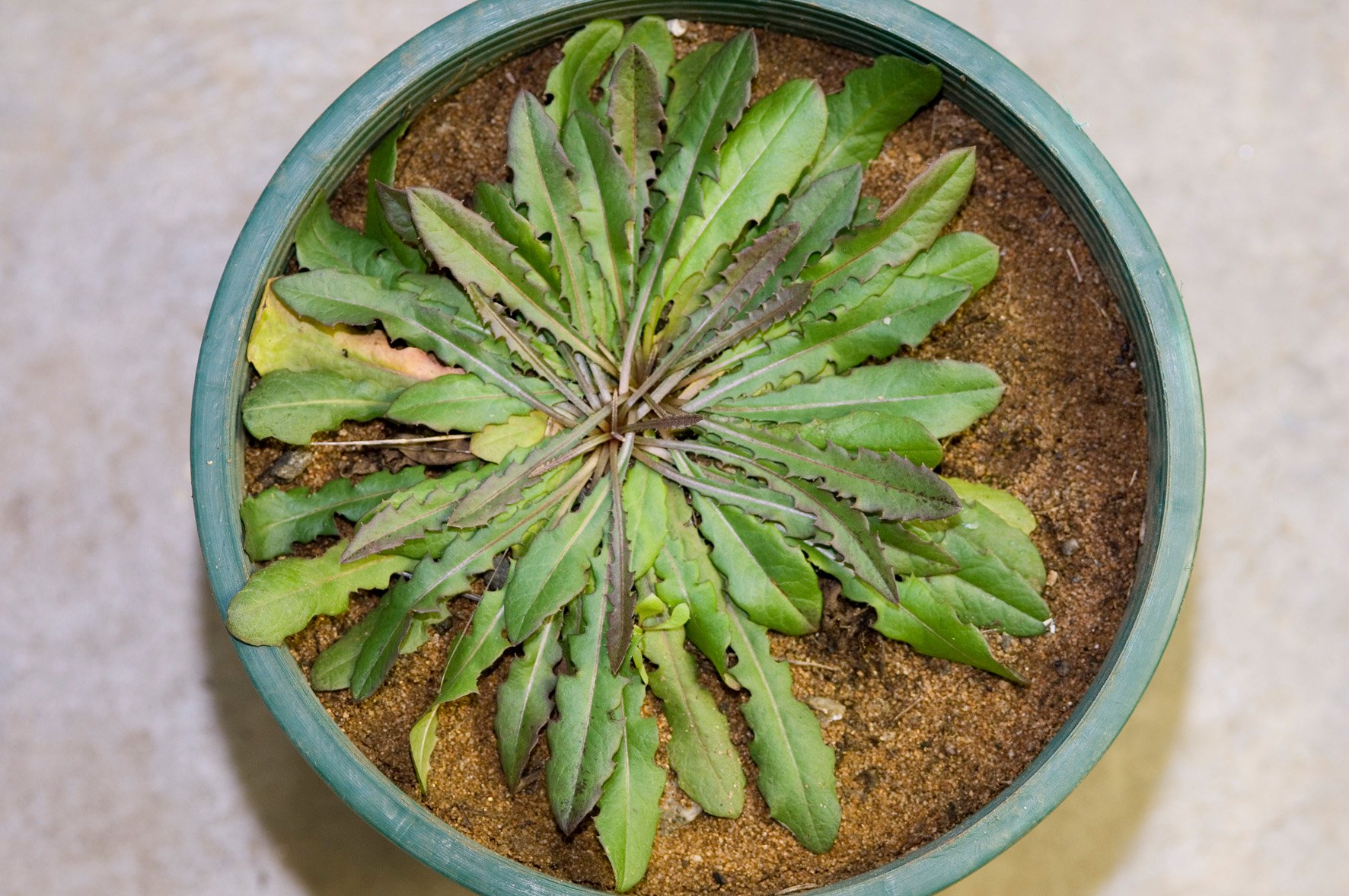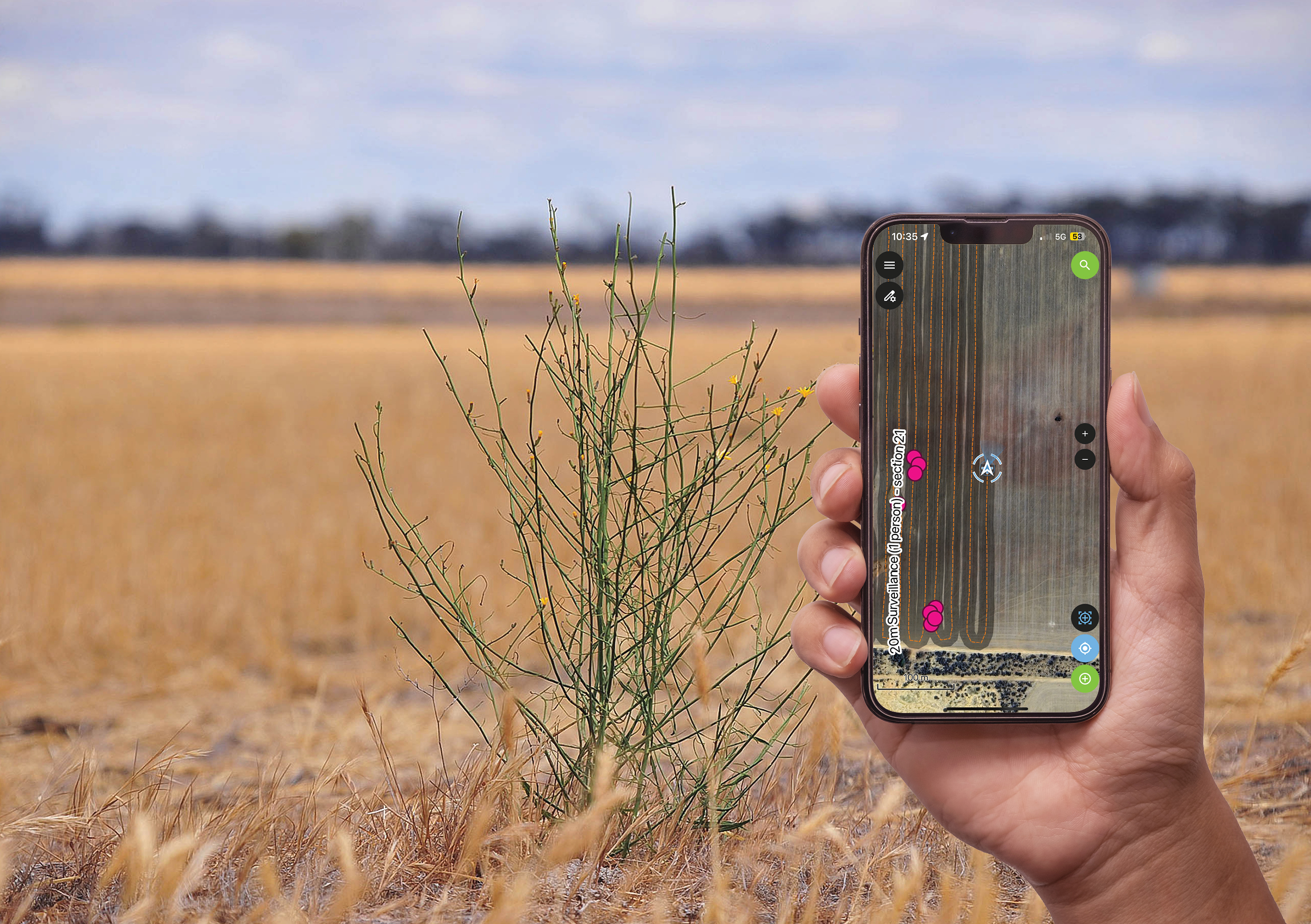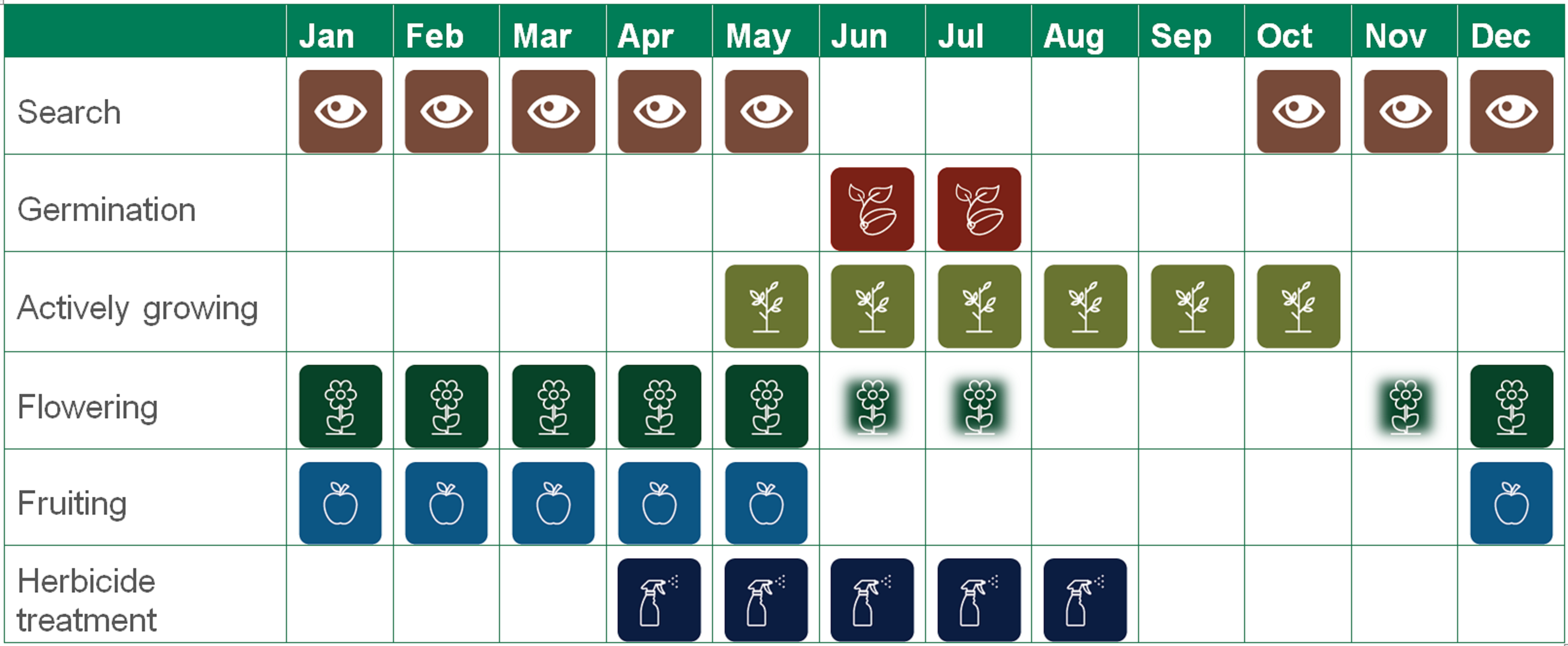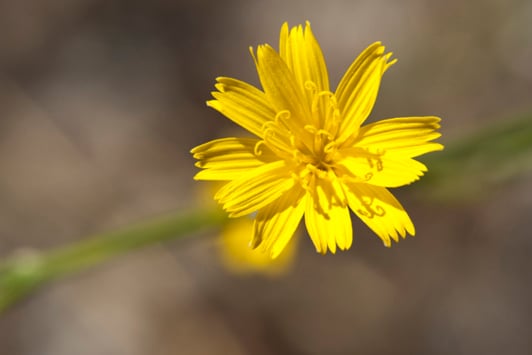Skeleton weed (Chondrilla juncea L.) is a high-priority eradication target for Western Australia. It is a declared pest and must be reported.
It's widespread and can be found in farm paddocks, along roadsides, along railway lines, on industrial land and around ports. Landowners and occupiers must adhere to search, detection, control methods and reporting as outlined below. Download the guides and fact sheets for detailed information.

Report skeleton weed detections
Report suspected detections of skeleton weed to either:
- Pest and Disease Information Service (PaDIS)
+61 8 9368 3080 | Email padis@dpird.wa.gov.au - MyPestGuide Reporter app or online tool (select 'Send report to MyWeedWatcher' from menu).

Digital landholder mapping tool
Landholder searching and mapping of skeleton weed is now easier with a free downloadable app, along with a mapping template provided by the department.
The app provides landholders with guidance for searching paddocks and produces track logs for validation of search assistance claims. It allows plants to be mapped, removing the need to mark infested areas using traditional methods like chemical drums, traffic cones or fence droppers.
To get started with the digital mapping tool, contact the Skeleton Weed Program team via email.
Find out more-
Landholder mapping guidepdf (3.46 MB)
Download step-by-step instructions to use the digital mapping tool.
-
Mapping templatebin (29 KB)
Download the template to use with the QField app.
Biological control of skeleton weed
The battle against skeleton weed in Australia’s grain belt took a significant turn in the 1970s with the introduction of 4 highly host-specific biocontrol agents into eastern Australia. There are 3 biotypes of skeleton weed in WA; each responds differently to the biocontrol agents available, due to genetic differences. The most common biotypes found in WA are the narrow-leaved and the broad-leaved forms.
The following 2 biocontrol agents are now available in WA. Download the flyers below for additional information on each one.
1. Gall midge (Cystiphora schmidti)
A small insect that forms galls inside the plant, causing tissue necrosis, leaf loss, stem and tip dieback, and reduction in seed production and viability.
2. Rust fungus (Puccinia chondrillina)
A plant pathogen that infects leaves and stems, causing desiccation, stunting and reduction of seed production and viability. It is extremely host-specific, so much so that it will only attack one of the 3 skeleton weed biotypes.
See also the section below on 'how to control skeleton weed'.
Skeleton weed is a declared pest under section 22(2) of the Biosecurity and Agriculture Management Act 2007 (BAM Act) which is currently under review. Refer to the relevant management implications below.
Control category C2: All of WA except Narembeen and Yilgarn
- Eradicate infestations.
- Destroy plants and prevent propagation each year, until no plants remain.
- Prevent the spread of seed or plant parts.
- Summer search is required.
- Winter control is required
Control category C3: Narembeen and Yilgarn
- Manage infestations to prevent the spread of seed or plant parts.
- Summer search is required.
- Treat plants to prevent seed set.
- Winter control is required to receive search assistance.
Anyone in the South West Land Division could find skeleton weed as it is widespread and can occur in different situations. It has been found on farms in a number of Wheatbelt shires.
Skeleton weed has been found in farm paddocks, along railway lines, on roadsides and on industrial land in the Perth metropolitan area, Fremantle and further south as far as Albany and Esperance. It is occasionally found in bushland and lawns.
It can be found in grain crops, skeleton weed is most likely to be found at harvest time. In other situations it is most recognisable when flowering, in summer and autumn.
Stems
- single stem to each rosette
- 50 to 125 cm tall, with numerous branches
- stems and branches are hairless except for a few rigid hairs at the base of the stem.
Leaves
- hairless, initially produced as many-leaved rosettes
- rosette leaves are spear shaped, 40 to 120 mm long and 15 to 45 mm wide, and can often be purple in colour
- leaf margins are deeply toothed with the lobes pointing backwards towards the base
- smaller leaves are sometimes borne among the branches of flowering stems.
Flowers
- numerous, bright yellow heads, each with 9 to 12 florets
- heads can be solitary or in groups of 2 to 5 and are attached directly on the branch
- flowers are about 20 mm in diameter
- usually flowers from December until May (though it has been found flowering in July in Perth).
Seeds
- brown, 3 to 4 millimetres long with numerous shallow ribs
- each seed carries a pappus of white bristles, 5 to 8 mm long
- the seeds are about 3 to 4 mm long with a parachute to aid wind dispersal.
Other characteristics
- relatively long-lived perennial with a deep tap root
- stems and roots exude white latex when damaged.
Biosecurity Officers and Local Action Group Coordinators
The department has a dedicated team of program-funded staff to provide support to land managers, undertaking operations in both rural and metropolitan locations. Your local Biosecurity Officer will guide you through the process to both identify and manage skeleton weed on your property, once finds are reported.
In addition, a skeleton weed Local Action Group (LAG) is a network of local farmers in a district affected by skeleton weed, each led by a LAG Coordinator. There are currently seven operational Local Action Groups in grain growing areas, designed to provide additional local support and in some cases work in collaboration with Biosecurity Officers.
Find your nearest office on our website.
LAG offices are listed below.
| Local Action Group | Phone |
| Avon South LAG | 0436 426 836 |
| Central Wheatbelt LAG | 0488 169 670 |
| Lakes LAG | 0409 351 373 |
| Lower Lockhart LAG | 0438 892 460 |
| Mortlock LAG | 0427 291 705 |
| Narembeen LAG | 0477 820 803 |
| Yilgarn LAG | 0477 964 891 |
Control recommendations
Control methods for this declared plant can be found in the Skeleton Weed Program's best management practice guide and control program documents, available below. Recommendations are reviewed annually based on chemical availability and research trials.
See also the section on 'Biological control of skeleton weed'.
Reporting finds prior to undertaking controls
Contact your local DPIRD Office, skeleton weed Local Action Group, the Pest and Disease Information Service or use the MyPestGuide Reporter App prior to completing any chemical controls.
Chemical recommendations for application on skeleton weed are reviewed and published annually and presented into a best management practice guide which is available to skeleton weed infested landholders and interested persons, with chemical mixes which will vary depending on the land use (crop, pasture, plantations or organic farms etc).
You may also be eligible for landholder assistance, support and advice through the Skeleton Weed Program which is funded by the Grains, Seeds and Hay Industry Funding Scheme.
Chemical considerations
When using any agricultural chemicals please ensure that you always follow instructions on the label and any permit. Users of agricultural chemical products must always strictly comply with the directions on the label and the conditions of any permit. To view permits or product labels go to the Australian Pesticides and Veterinary Medicines Authority website.

The department has developed the Skeleton Weed Program with support from the Grains, Seeds and Hay Industry Funding Scheme. The Program aims to manage skeleton weed in WA’s wheat growing areas.
The main objective of the Program is to assist landholders to eradicate skeleton weed and to prevent its further spread within WA. This is achieved through strong support from:
- The department
- an effective control program for affected properties
- the detection of newly infested areas via a targeted surveillance program before skeleton weed can become established.
The Program provides significant benefits for grains, seeds and hay industries through its eradication and management program, successfully eradicating skeleton weed from a number of properties and limiting the spread across the grain and hay growing areas of WA.
An important mechanism for delivering the project activities is achieved through the funding of Local Action Groups (LAG’s). These groups undertake the delivery of program activities in a particular area (usually a shire or group of shires) thanks to strong local support in their communities.
Background and funding
The first report of skeleton weed in Australia occurred near Marrar in New South Wales in 1917. Although details are unknown, it most likely entered as seed with vine stocks, in animal fodder or bedding from Southern Europe. It spread throughout the south-eastern Australian wheatbelt during the 1920s to 1940s, dramatically reducing yields and proving difficult to control. Over time, three distinctive forms emerged, a narrow-leaf (most common), an intermediate-leaf and a broad-leaf form, distinguishable by the basal rosette leaf shapes.
The first skeleton weed detection in Western Australia (WA) occurred at Ballidu in 1963. Following the discovery of several large infestations in the Narembeen shire in 1973, the Skeleton Weed (Eradication Fund) Act 1974 was passed by Parliament to enable grain producers to self-fund ongoing eradication efforts via a levy on grain producers. This arrangement remains in place, but now operates under the Biosecurity and Agriculture Management Act 2007. The levy is reviewed annually and supports both the Skeleton Weed Program and Three-horned bedstraw (Galium tricornutum Dandy) Program. (Cook DC. Benefit-cost analysis of skeleton weed (Chondrilla juncea) management in Western Australia).
The program is delivered by DPIRD under a service delivery arrangement with the Grains, Seeds and Hay Industry Management Committee. The Committee acts under the Biosecurity and Agriculture Management Industry Funding Schemes (Grains) Regulations 2010 to manage prioritised pests affecting the grains industry. The Grains, Seeds and Hay Industry Management Committee is funded through contributions raised on the sale of grain, seed and hay.
Services provided by the program are only available to landholders who contribute to the Grains Industry Funding Scheme through the sale of grain, seed or hay. Landholders not under the scheme but who have skeleton weed on their properties are still required to meet their obligations under the program but at their own cost.
Program strategies
- Improve landholders’ ability to find and eradicate skeleton weed.
- Increase landholders’ awareness of skeleton weed as a highly undesirable weed.
- Widely publicise descriptions and pictures of skeleton weed to help landholders identify infestations.
- Inform landholders about the most up-to-date techniques available for the management and eradication of skeleton weed.
- Provide assistance with searching and eradication.
- Encourage local grower groups (Local Action Groups) to participate in cooperative surveillance and reporting of infestations.
- Encourage Local Action Groups to assist in the management and eradication of skeleton weed in their local areas.
- Implement practical compliance regimes in affected areas.
- Provide landholders with incentives to report infestations.
- Provision of winter control treatments where landholders are compliant with program requirements.
Summer searching and surveillance
The Skeleton Weed Program undertakes annual summer surveillance of paddocks with high chances of having skeleton weed.
The department has been carrying out a targeted surveillance program since 2002 with the objective to find infestations in areas considered a high risk of having skeleton weed. This program also raises awareness of the presence of skeleton weed on high risk properties. It occurs on non-infested properties between December and March in grain growing areas.
Properties chosen for surveillance are considered to have a high probability of having skeleton weed, due to being near or adjacent to a current skeleton weed infested property. Other properties are identified from analysis of current infestation locations, and predictions of spread from these locations.
Surveillance involves checking a minimum of three paddocks over summer (preferably crop stubbles) on each selected property. The aim is to search up to 300 hectares per property.
Landholders or managers will be contacted via phone and correspondence to advise of impending scheduled surveillance and confirm which properties can be searched. Paddocks should be livestock-free and unsprayed for four weeks, and allow 5-10 days before departmental searching of harvested paddocks; this will allow skeleton weed to grow above the stubble.
Why skeleton weed is a threat to WA
Skeleton weed can reduce grain crop yields due to its deep perennial root system and interfere with harvesting as its wiry stems are still green at harvest time.
Bioeconomic modelling results suggest without the Skeleton Weed Program and if it's left unmanaged, over 100,000 hectares could become infested over the next 30 years, with resultant damage estimated to be $13.6 million per year (annual crop yield losses and increased growing costs), but with the program and managed, expected costs to producers fall to $5 million per year.
If annual program costs remain approximately $3.4 million per annum, the avoided losses attributable to the program is likely to produce an annual net benefit to grain producers of $8.6 million and a benefit-cost ratio of 1.3 over 30 years.
Learn more about the benefit-cost analysis of skeleton weed (Chondrilla juncea) management in WA by reading the research paper.
Skeleton weed documents
-
Annual Report to Grain Growers: Skeleton Weed Program 2023-24
-
Skeleton weed in Western Australia: 2025 Management guide
-
Skeleton weed in Western Australia: Control program 2024–25
-
Skeleton weed: declared pest factsheetpdf (3.44 MB)
-
Biotypes of skeleton weed in WApdf (421 KB)
-
Using biocontrol to combat skeleton weedpdf (827 KB)
Contact us
-
Skeleton weed program

